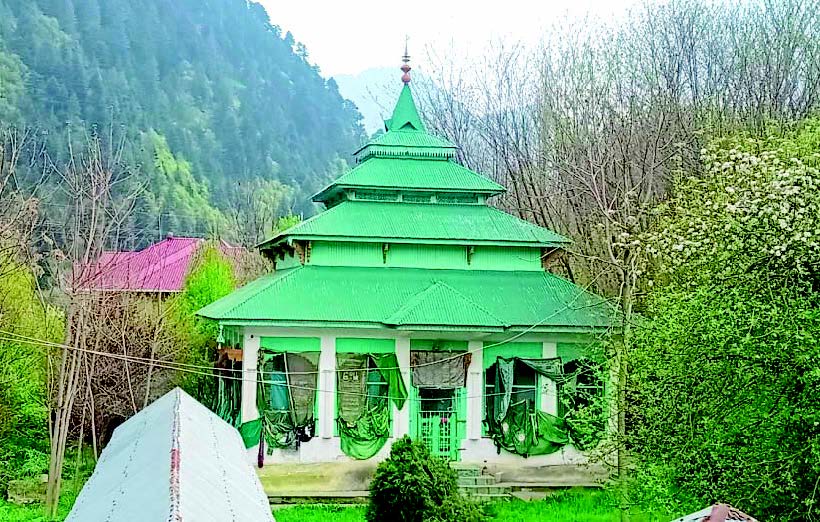Play all audios:
The village of Peerniya is situated on the right bank of the river Jhelum, offering panoramic view of the Pir Panjal range. Located approximately 15 kilometres from the administrative
headquarter of Baramulla along the well-known Srinagar-Muzaffarabad route, this picturesque hamlet is characterized by its geographical location, flanked by the river Jhelum on one side and
the canal of the Lower Jhelum Hydel Power Project (LJHP) on the other. The etymology of the village’s name lacks written documentation. Local oral tradition, however, suggests that the
locale was formerly known as ‘Parivan’ or ‘Paristan’, a toponym that gradually evolved over time into ‘Peerniya’. Many of my respondents such as Mohammad Jaffar Massudi and Mohammad Sayed
Massudi also confirmed this narrative. There is no doubt that the valley of Kashmir has remained the epitome of knowledge, traditions, culture and religion. It is because of that Kashmir was
thronged by the _Rishis_ from different parts of the world. With the Islamisation of the valley in the 14th century a new era started in the history of Kashmir. The Islamisation of the
valley was mostly operated by Muslim missionaries from Central Asia, popularly known as _Sufis._ These spiritual emissaries not only propagated the teachings of Islam but also fostered the
development of various arts and crafts, thereby contributing significantly to Kashmir’s cultural heritage. One notable figure among these luminaries who promoted and propagated Islamic
teachings, also art and craft, was Hazrat Baba Abdul Ghafoor. He is popularly known as “Baba Ghafoor”. Despite the dearth of written records directly pertaining to this shrine, the recent
publication of his biography titled _Qalandari Saani_ provides valuable insights into his life and contributions. Furthermore, oral traditions serve as invaluable source for understanding
and reconstructing his historical legacy. According to the inscription on the “Sang-i-bunyad” (Foundation Stone) of this shrine, Hazrat Baba Abdul Ghafoor was born circa 1006 Hijri (1598
C.E.) and passed away in 1105 Hijri (1694 C.E.). The administration of this shrine is entrusted to a dedicated committee, and the information herein presented is derived from interviews
conducted with few members of this body. According to Mohammad Sayed Massudi, “Hazrat Baba Abdul Ghafoor was born in Narwar Srinagar and hailed from the esteemed lineage of Baba Massudin
NarawariRA, ultimately passing away in Peerniya.” In pursuit of religious enlightenment, Hazrat Baba Abdul Gaffoor left for Multan, renowned as _Madinat-ul-Auliya,_ a revered center of
Islamic scholarship. Under the guidance of the venerable teacher Bu Ali QalandarRA, he acquired the knowledge and wisdom that would later enlighten his mission. Following his education in
Multan, Hazrat Baba Abdul Ghafoor received a divine directive from his _Murshid_ (Teacher or Guide) to return to Kashmir and propagate the teachings of Islam. He subsequently settled in
Peerniya, where he engaged in pastoral pursuits in the nearby village of Manzgam. It was during this time that he married to a local woman known as “Daed Saab.” Currently, the shrine of
“Daed Saab” predominantly attracts female devotees. It is documented that Hazrat Baba Abdul Ghafoor had two offspring from her, both of whom tragically died in infancy. Additionally, he
entered into matrimony with a woman from Peera Muqam, a village situated approximately 20 kilometres distant from Peerniya. According to Mohammad Syed Massudi “Hazrat Baba Abdul Ghafoor is
credited with numerous _Karamats_ (miracles), among which a prominent event involves his striking of an _Aasa_ (staff or stick) upon a stone in the village of Hakapathri, resulting in the
emergence of water that is used for drinking purpose as well as irrigating the agricultural fields even today. Another noteworthy event entails the transformation of sand into rice during
cooking, an act of providence extended to an elderly woman facing scarcity of rice.” Hazrat Baba Abdul Ghafoor is remembered for his endeavours to cultivate barren lands and his
encouragement of agricultural expansion. The custodians of his shrine maintain a tradition of distributing sand to individuals for sprinkling upon agricultural fields, specifically to combat
agricultural diseases and rodents. Furthermore, he instituted a _Langar_ (communal kitchen), funded by local agricultural produce contributions totalling one _trakh_ (approximately 6
kilograms) annually from each household. This charitable initiative remains a testament to his commitment to communal welfare and social cohesion. According to the accounts provided by
Mohammad Syed Massudi and Mohammad Jaffar Massudi, “Hazrat Baba Abdul Gaffoor maintained a lifelong abstention from the consumption of non-vegetarian foods, including fish, chicken, beef, or
any form of meat.” Syed Massudi recounted an incident where Hazrat Baba Ghafoor accepted an invitation of his uncle from Sopore, contingent upon the condition that no animal would be
slaughtered along the route to Sopore. Unfortunately, this condition was breached when a butcher in Baramulla slaughtered an animal, leading to a catastrophic fire upon Hazrat Baba Ghafoor’s
arrival that engulfed the entire town. Consequently, Hazrat Baba Ghaffoor refrained from visiting marketplaces thereafter. Devotees intending to visit the shrine are traditionally required
to observe a three day long abstinence from consuming non-vegetarian foods. This shrine is visited by the devotees irrespective of religion, cast, creed and sect. This shrine mostly visited
on Thursday morning to seek blessings. Notably, Hazrat Baba Ghafoor is said to repose within a coffin rather than being buried, as confirmed by Mohammad Syed Massudi. Syed Massudi also
recounted an episode which he had heard from his elders; “During the Durrani or Afghan rule (1752-1819 C.E.), wherein an Afghan governor dispatched troops to forcibly open the coffin under
the mistaken belief that it contained treasure. However, all soldiers of the expedition purportedly lost their eyesight and were afflicted with blindness.” This three hundred year old shrine
was renovated in 2007. His _Urus_ (Death anniversary) is celebrated with religious fervour every year on 25-26th Safar of Hijri calendar. By Zahid Iqbal Sheikh [email protected]
_Zahid Iqbal Sheikh, Ph.D. Research Scholar, Department of History, Maulana Azad National Urdu University, Hyderabad._

